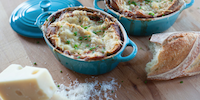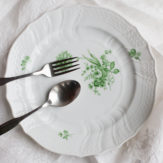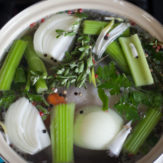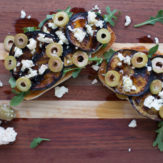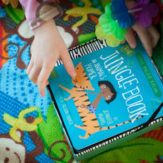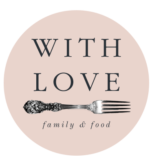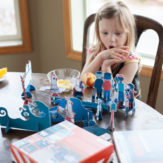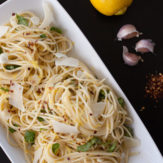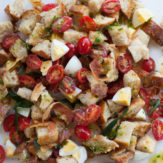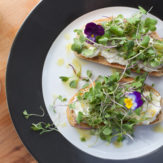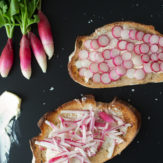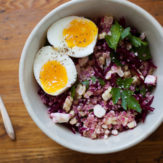.jpg) PIN
PIN
After reading French Kids Eat Everything and following that approach to menu planing for the past six months, I reworked the way I was menu planning to meet the new way I was feeding my family. This meant not only planning dinners but also planning out breakfasts, lunches and snacks. At first I found this really overwhelming and couldn’t figure out a way to keep track of it all. I struggled (and still do sometimes) with trying to cover the entire days worth of food, seven days a week for my family but this method has streamlined the process and made it enjoyable and affordable!
It can seems a little overwhelming at first so I’ve broken it up into a few separate parts…
Three Steps to Menu Planning
01. Cookbooks and Organization
.jpg) PIN
PIN Menu Planning // Step One
Menu Planning // Step One
One issue I continuously had when menu planning was that I can’t always find the time to browse through my cookbooks for inspiration and recipe ideas. Before we had Gigi, Kyle and I would spend our Sunday morning in bed, with our cookbooks and our coffee, making a menu for the week… now I need this process to be much more efficient. I used to plan for a week at a time but I personally find that doing a month at a time makes it so much easier, takes less time, and helps me keep our whole month’s budget in mind.
I went through every cookbook we owned, one at a time, using little Post-It’s to flag the recipes that looked good, that I regularly made, or that I had always wanted to make. If I went through a cookbook and only found one of two recipes that I liked/used I just put that cookbook in the pile for a the used bookstore… there are so many amazing cookbooks and recipes and streamlining the number of cookbooks I had really helped this process.
THEN I went through the cookbooks and typed all the recipe titles into the following categories: Breakfast. Lunch. Snack. Dinner (split into entrees/sides and main courses). Dessert. Drinks. Basics and Techniques. I also created hyperlinks in my document to my favorite food blogs. You could create as many or as few categories as you need for your family. Since I’m a stay at home mama who loves to cook (and eat) I needed all of them! Each section is divided up with headings for each cookbook. For example under BREAKFAST I have six different cookbooks that I took recipes from.
The BREAKFAST section looks like this:
BREAKFAST
My Father’s Daughters.Gwyneth Paltrow
sweet rice bowl GP.236
morning pancakes GP. 221
spiced apple crumb muffins GP.224
favorite granola GP.227
bruce’s world-famous pancakes GP.239
Sprouted Kitchen.Sarah Forte
breakfast tostadas SK.28
scrambled eggs and leeks SK.32
vegetable eggs benedict SK.31
softly scrambled eggs with creamy leeks SK.32
carrot-date muffins SK.34
creamy coconut barley with pomegranate molasses SK.39
tofu quiche in rosemary-almond meal crust SK.44
granola protein bars SK.154
green smoothie SK.162
…you get the idea. I gave each cookbook and a code before the page number so when I’m menu planning I don’t have to write our “Sprouted Kitchen” every time, just SK and the page number!
This process took a couple of weeks to complete but it was really enjoyable, I made tea and flipped through my beloved cookbooks with a stack of Post-It’s at hand. Admittedly putting them into a document on the computer felt a little tedious but I just I tackled one cookbook every other day or so and now that it’s done I’ve found that the menu creating process is really fast and filled with variety.
Here is a list of my current cookbooks:
My Father’s Daughter // Gwyneth Paltrow
It’s All Good // Gwyneth Paltrow
The Sprouted Kitchen // Sarah Forte
Start Fresh // Tyler Florence
Super Natural Every Day // Hedid Swanson
Joy the Baker // Joy Wilson
Very Fond of Food // Sophie Dahl
Spain: A Culinary Road Trip // Mario Batali
Tyler’s Ultimate // Tyler Florence
Jamie’s Kitchen // Jamie Oliver
Everyday Italian // Giada de Laurentiis
I also have some bigger cookbooks like America’s Test/Cook’s Illustrated Kitchen Family Cookbook, Interational Recipes, and New Best Recipes. I also have Mastering the Art of French Cooking and The Joy of Cooking. I didn’t go through these since they are so packed with recipes. I tend to reference them as needed or when I’m looking for something specific.
Some cookbooks on my wishlist:
Miss Dahl’s Voluptuous Delights: Recipes for Every Season, Mood, and Appetite
Tender: A Cook and His Vegetable Patch
The Art of Simple Food: Notes, Lessons, and Recipes from a Delicious Revolution
Plenty: Vibrant Recipes from London’s Ottolenghi
The Smitten Kitchen Cookbook
What Katie Ate: Recipes and Other Bits and Pieces
It’s All Good: Delicious, Easy Recipes That Will Make You Look Good and Feel Great
Miette: Recipes from San Francisco’s Most Charming Pastry Shop
The Sugar Cube: 50 Deliciously Twisted Treats from the Sweetest Little Food Cart on the Planet
Tartine
Home Made
Bouchon Bakery
…and so many more! What are your favorite cookbooks?
My favorite food blogs:
Gorge in the Gorge
(this is my food blog so i use a lot of recipes from here!)
GOOP
Joy the Baker
Orangette
101 Cookbooks
Call Me Cupcake
Cannelle et Vanille
Dinner or Dessert
La Domestique
Love and Olive Oil
Naturally Ella
Not Without Salt
Reclaiming Provincial
Smitten Kitchen
Sprouted Kitchen
Sunday Suppers
Tartelette
The Forest Feast
What Katie Ate
Step 02 / Menu Planning and Grocery Shopping Lists
 PIN
PIN
The second step is using those recipes to create a monthly menu that is full of variety and sticks to your budget. I think shopping within a reasonable budget is the hardest part of meal planning. It definitely the most “troublesome” part of our family budget. It’s a challenge to stay under $450 (our monthly goal) but this method makes it easier. I also have some tips for budget friendly grocery shopping that I’ll share in Step Three.
I’ve broken my monthly planning down into week by week menus. I plan out breakfasts, lunches, snacks and dinners. I don’t plan out desserts since we don’t have it every night. Lately, when I’m at the store I just buy whatever fruit looks good, then we’ll share an apple or a banana and a few chocolate chips. If we have ice cream, or if Gigi and I have baked a little cake then we’ll have that. I plan out each week using a little budget code (under $5 / $=5-10 / $$=10-15 / $$$=15-20 / $$$$ = 20+). I write in my estimate next to the meal and I try to keep most of my meals in the “under $5” category. A – indicates that there is no cost because it’s leftovers. It depends on your budget and the size of your family, but I find that this little system helps me see when I’m planning too many pricey meals. These menu plans actually end up covering a little over a month since we usually do a day here and there using up what we have in the fridge, or we get invited out to dinner and have extra food on hand for a meal or two.
 PIN
PIN So, I fill out the menu using my recipe document and selecting this off of my favorite foodie blogs. I make my menu plan on the computer which makes it easy because I can just copy and past the recipe from my cookbook document or hyperlink the online recipe directly into this format. I try to keep notes about what new foods I introduced to Gigi to keep in mind the French Kids Eat Everything method we’ve been following. I also make sure to note when I can “make one, freeze one” and double that recipe and put one in the chest freezer in the garage. Where you see “RECIPE” written out is a meal that I’ve dedicated to creating or working on a new recipe. You could also leave space for spontaneous meal planning.
So, I fill out the menu using my recipe document and selecting this off of my favorite foodie blogs. I make my menu plan on the computer which makes it easy because I can just copy and past the recipe from my cookbook document or hyperlink the online recipe directly into this format. I try to keep notes about what new foods I introduced to Gigi to keep in mind the French Kids Eat Everything method we’ve been following. I also make sure to note when I can “make one, freeze one” and double that recipe and put one in the chest freezer in the garage. Where you see “RECIPE” written out is a meal that I’ve dedicated to creating or working on a new recipe. You could also leave space for spontaneous meal planning.
 PIN
PIN
 PIN
PIN Once I’ve created the entire months menu I get down the corresponding cookbooks and pull up the food blogs. Then I go week by week to create a grocery shopping list for each week. I put everything I can (non-perishables) onto the week one grocery list. By buying everything I can at the start of the month I accomplish a few things. First, it allows me to spend the bulk ofmy grocery budget up front and then I know how much I can spend the remaining three weeks. Second, it means I have one big grocery shopping trip each month. The rest of the month I have short trips to pick up fresh produce, poultry and dairy. Third, it gives me a chance to look for things on sale and buy them early on and stick them in the freezer for later in the month. Finally, this also means that I only have to look through the pantry/freezer/spice cabinet once each month instead of weekly to see if we already have this or that!
Once I’ve created the entire months menu I get down the corresponding cookbooks and pull up the food blogs. Then I go week by week to create a grocery shopping list for each week. I put everything I can (non-perishables) onto the week one grocery list. By buying everything I can at the start of the month I accomplish a few things. First, it allows me to spend the bulk ofmy grocery budget up front and then I know how much I can spend the remaining three weeks. Second, it means I have one big grocery shopping trip each month. The rest of the month I have short trips to pick up fresh produce, poultry and dairy. Third, it gives me a chance to look for things on sale and buy them early on and stick them in the freezer for later in the month. Finally, this also means that I only have to look through the pantry/freezer/spice cabinet once each month instead of weekly to see if we already have this or that!
Important Note: I l keep the menus on the fridge so I can always see what’s coming up for the week. This keeps me excited about what on the menu, aware of what I’ve already spent money on and far less likely to order take out.
I love grocery shopping with my daughter but sometimes it feels like it takes up the entire day! I split my grocery list up into “parts of the store” which makes it easier to efficiently shop, it also makes it easier for Kyle when I send him to the store. I spend so much less time criss-crossing the store because I forgot something on the other side! This might vary a little depending on the layout of your store. I also added a separate section of stopping by the co-op or farmer’s market, and for things we need from Safeway or Trader Joe’s (which aren’t our usual grocery stores).
Here is a look at my blank document for grocery shopping… (you can print this at the end of the post)
 PIN
PIN
And here’s what a few of my lists look like…
 PIN
PIN
You can see my grocery list for Week 1 is bigger than the others! Last month I spent $95 week one and I’ve spent around $50 each additional week. Along with little trips to the store here and there we are sticking pretty close to our budget.
I know this all looks like a lot of work (and it is) but it’s totally worth it! I find a day at the end of the month and spend long morning making up the menu and grocery lists for the month. Then the work is done for the whole month! I don’t have to stress about it every Sunday, I just grab the next week’s menu and list. A major benefit to planning this way is that, once you have several months of menus made up you can always go back and print an old month when you’re in a time crunch.
PRTINABLE MENU TEMPLATE.
Monthly Menu Template
PRINTABLE GROCERY TEMPLATE.
Grocery List Template
Step 03 / Top Tips for Shopping on a Budget and Shopping with Kids
 PIN
PIN Keeping groceries within our budget can be a big challenge for us. We love to cook and eat and our grocery store spending can easily get out of hand. When we are really tightening our belts I can get our budget down to $200/300 per month but that isn’t very sustainable for us. We set our budget at $450 which gives us enough to eat wholesome foods, create a couple recipes and maybe splurge on ice cream.
Keeping groceries within our budget can be a big challenge for us. We love to cook and eat and our grocery store spending can easily get out of hand. When we are really tightening our belts I can get our budget down to $200/300 per month but that isn’t very sustainable for us. We set our budget at $450 which gives us enough to eat wholesome foods, create a couple recipes and maybe splurge on ice cream.
Top Tips for Grocery Shopping on a Budget
Buy everything you can at the start of each month.
When I make my monthly menus I also make my whole months worth (four in total) of grocery lists. I put everything I can on the list for week one. Anything non-perishable goes on the first shopping list for the month. That way I spend the bulk of my grocery budget up front and I can keep that in mind the rest of the month. This really helps be know approximately how much I have left to spend each week. You can read about this in depth here.
Only buy what is totally necessary from the organic section.
I used to buy all organic but our spending dropped significantly when I started buying conventional again and only buying what was totally necessary from the organic section. This summer we’ll have a big garden planted and the local farmers’ market will be up and running so we will be able to eat more organic vegetables then! I just can’t afford to buy them from the store at this time in our life.
The most important things to buy organic are thin skinned fruits (apples, peaches, nectarines, grapes), thin skinned or exposed vegetables (bell peppers, celery, spinach, kale, collard greens, lettuce), potatoes, tomatoes, berries (especially strawberries and blueberries), red meat, high fat dairy (milk, butter). Organic dairy isn’t in our budget so I buy the Sunshine brand which is rbST free.
Wash and store fruits and vegetables properly.
Always make sure to wash and store your fruits and veggie immediately. I soak leafy greens and fresh herbs in a cold water bath, wrap them in paper towels and store them in ziploc bags. Quickly rinse fruits and store them in the proper drawer or in a fruit bowl on the counter. When I do this I find that the veggies last longer because they’re stored properly and I’m more apt to use them because they’re already washed! Likewise when the fruits are clean and on the counter in a nice bowl I use them quickly because they look appealing and are at my fingertips.
Buy in bulk whenever possible.
I buy everything I can in bulk. Mostly I buy dried fruit, flour, olive oil, dried beans, corn meal, rice, spices and herbs, oats, nuts, vanilla and honey. Even buying the bag of organic potatoes vs. individual potatoes can save quite a bit! The cost per volume is almost always better when you are buying in bulk.
Be thoughtful about what you stock up on.
I used to stock up on everything… I’d just buy three of things when they were on sale. But I found that cans of this or that sat around forever so I was actually wasting money up front (rather than saving it). The main things I stock up on now are broths (I love the low sodium, organic Trader Joe’s brand of chicken and veggie broths. I buy a case of each when we go!) I also stock up on cheeses like goat cheese, Parmesan, mozzarella and cheddar. As long as the cheese is sealed in it’s original packaging it should last for quite some time. Trader Joe’s is also a great place to buy cheese! Now when we go to Costco we only buy household products and skip the majority of the food. It’s so easy to buy things you don’t need because they’re such a good deal!
Buy and freeze.
The main things I buy and freeze are whole grain bread and chicken. In fact I only buy bread when it’s on sale. Often whole grain bread can be 50% off when it’s close to the expiration date. I’ll buy two and freeze them both. I try to only buy chicken when it’s on sale, and usually in larger quantities like the “fryer packs”, then I divide it up into dinner size ziploc bags, write the date on them and pop them in the freezer. Because the menu planning is done for the month all at once I have plenty of time to see what I already have and pull it out to defrost in the fridge.
Make one, freeze one.
One big thing I do is to double recipes and freeze one. I especially try to do this with meals that are inexpensive like my Tuna Noodle Casserole, Enchiladas, and lasagnas. But I also do it with Chocolate Chip Cookies, homemade pizzas… anything that will freeze well. This gives us convenient, inexpensive meals and it doesn’t add much time to make two instead of one.
Skip the boneless, skinless variety of chicken breasts.
You can save a ton by buying bone in, skin on breasts instead of boneless skinless breasts and they cook so much better! A little bit of olive oil, salt and pepper roasted on a cookie sheet at 375 degrees F for about 45 minutes and you’ll have the most tender, flavorful chicken breasts. Once they’ve cooled a tiny bit just remove the skin and cut the meat from the bone. I shred these for enchiladas and salads, dice them for chicken salad sandwiches, etc.
Use what you have.
This may seem obvious but it’s easy to get lazy when making menus and not get up to look to see if you already have a can of tomatoes in the pantry or a bottle of red wine vinegar in the fridge. A few dollars here and there really adds up. Because the menu planning and grocery list making is all done at once (with my method) that means you only have to search through the back of the pantry/spice cabinet/freezer once each month!
Also we always have a couple of “pantry meals” towards the end of the month when we try to use the other half of the jar of pasta sauce, the half used box of pasta, the milk that’s about to expire, the vegetables on the edge of perishing. They aren’t always the most creative, fun, or prettiest meals but it feels good to know that we used everything we could and didn’t waste anything!
Keep the season in mind.
It’s always less expensive (not too mention better for the environment) to buy what’s in season and grown locally. During the fall and winter our grocery spending always goes up since it’s harder to buy seasonal/local during the colder months. I try to pinch pennies but using hearty herbs like thyme, sage and rosemary in the fall and using dried herbs in the winter. I avoid buying things like fresh tomatoes, tropical fruits, etc. in the colder months. In just a few weeks we will be planting all of our vegetables in the ground and then we’ll be counting the days until our garden is in full bloom!
Edit your recipes.
I always try to edit recipes by omitting things that I don’t feel are totally necessary. I cut out things that are expensive or specialty items that are hard to find or will cost too much. I do this each month when I’m making the grocery list… when I come across an item I know is pricey I simply make the choice whether or not we can afford it within our budget. A lot of times I cut out the fresh herbs like basil or mint during the fall and winter, and if it’s appropriate, I substitute with less expensive options like flat leaf parsley. I also substitute expensive items like Gruyere cheese for a little blend of mozzarella and Parmesan. It does effect the recipes to some extent but I can’t afford to spend $2.50 on a handful of fresh herbs that are a garnish.
Shop at more than one grocery store.
I have to admit, I hate this step, but it’s a necessary one. For some reason I hate going to Safeway but they often have items that are less expensive than our favorite grocery store. I get everything I can from our main store but set aside a few things on our list from Safeway or another store… I buy all of our wine at the drug store where it’s usually a couple dollars less! To be honest I usually make Kyle do the Safeway run because he can do it on his way home from work and I don’t have to drag Gigi to another store.
Skip the processed foods.
Processed foods are expensive! The only things we buy from the middle of the grocery store (where processed foods are kept) are bread, canned/jarred tomato products, frozen berries, wine/beer, vinegars, mustard, coffee and tea. I never buy crackers or cookies or things like that. You can save a lot of money by making your own salad dressings, dry rubs or marinades. My favorite salad dressing is the Caesar Salad Dressing in this recipe.
Top Tips for Fun and Efficient Grocery Shopping (with kids)
Make it as fun as possible.
I don’t always look forward to going grocery shopping. In fact, sometimes I dread it. But I try to keep in mind that grocery shopping is something I will be doing every week for the rest of my life so I may as well make the best of it. Also, if I’m not having fun, neither will my kids. When I am in a good mood about it, organized, and upbeat, it usually ends up being a pretty fun errand. It’s a chance to teach Gigi about food, interact with other people, and do something that benefits my family.
Plan menus by the month.
By menu planning by the month (as opposed to week by week) I save a ton of time. The time is spent in one big chunk up front at the start of each month and the first grocery shopping trip is the most time intensive, but the rest of the month the trips are short and sweet. I just pick up fresh fruit and produce, meat, eggs and dairy. After the first big trip we usually go out for a little lunch or I plan something simple like peanut butter and jelly sandwiches. We always come home hungry and since I’m spending the time putting away our groceries and washing our veggies it works best if I have something simple planned.
Don’t give kids food at the store.
With the exception of a slice of apple which Gigi’s favorite produce guy slices for her, I don’t let her have any food at the store. I know a lot of parents who give their kids treats upon entering the store, or at the end of shopping as a bribe and I don’t doubt that it works well but we stick to our French Kids Eat Everything ways and I don’t let her snack and I don’t use food as a bribe or reward (sometimes I wish I did). Because I’ve been really consistant about this Gigi doesn’t usually ask for food while we are shopping. Occasionally she’ll spot a squeeze packet of baby food and will say, “I need dat! Peeeeeease Mama? I ask nicely.” But I stick to my rule and tell her, “No but as soon as we get home we’re going to have _________ (something fun) for lunch!” She usually handles this just fine. If she gets frustrated, I talk to her about how great lunch is going to be, how I got strawberry jam for her sandwiches, etc. Just talking about food she’s going to get to have is enough of a distraction.
Give kids a food related activity.
A great activity for kids at the store is to give them their own list. Gigi was always grabbing mine and didn’t want to give it up when I actually needed it. So I make her her own list with little drawings of items are on our list for the week/month. I draw little pictures and write the names of the foods next to them… I try to focus on new foods that we’re introducing. Then I give her a pen and she “helps”. The list usually gets tossed aside or torn into pieces by the end of our big trip to the store but it buys quite a bit of time and it gives us a chance to talk about new foods we are introducing that month! (You can download her March list below but I’m not exactly an accomplished artist)
 PIN
PIN
.jpg) Menu Planning // Step One
Menu Planning // Step One


.jpg)

.png)
